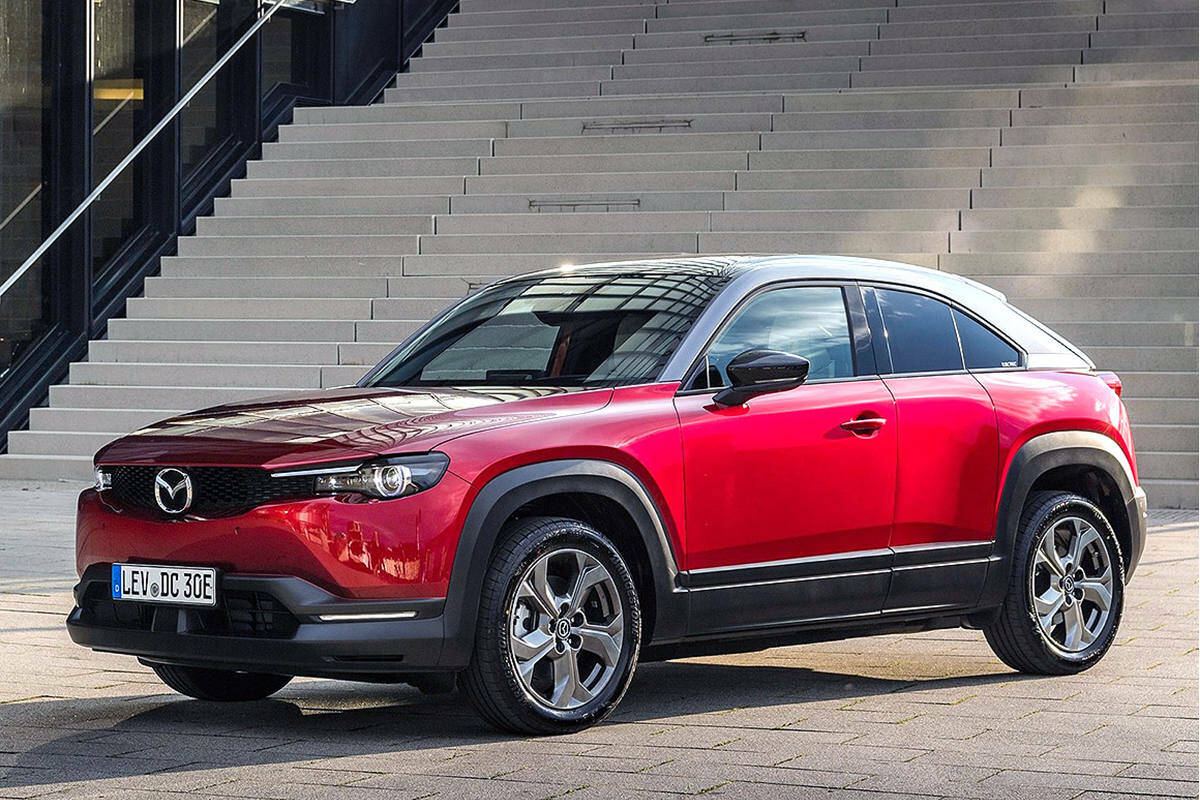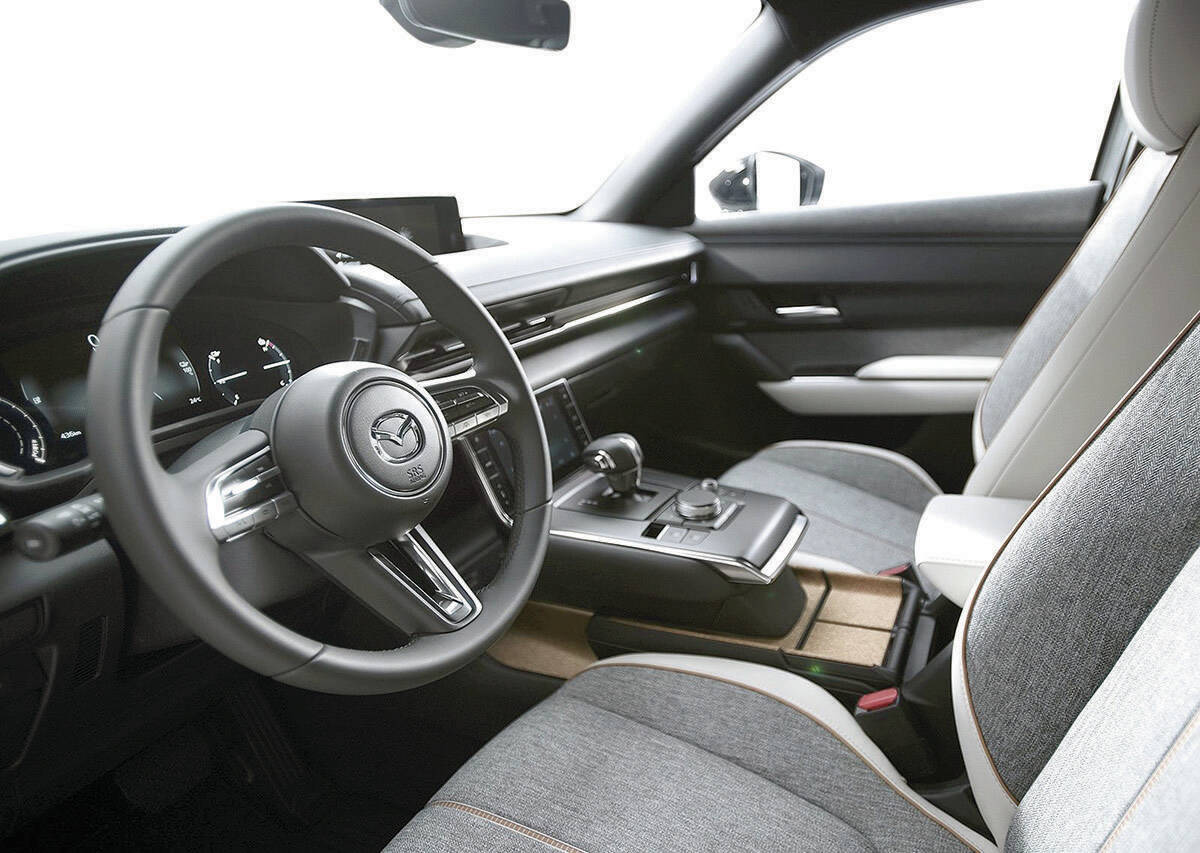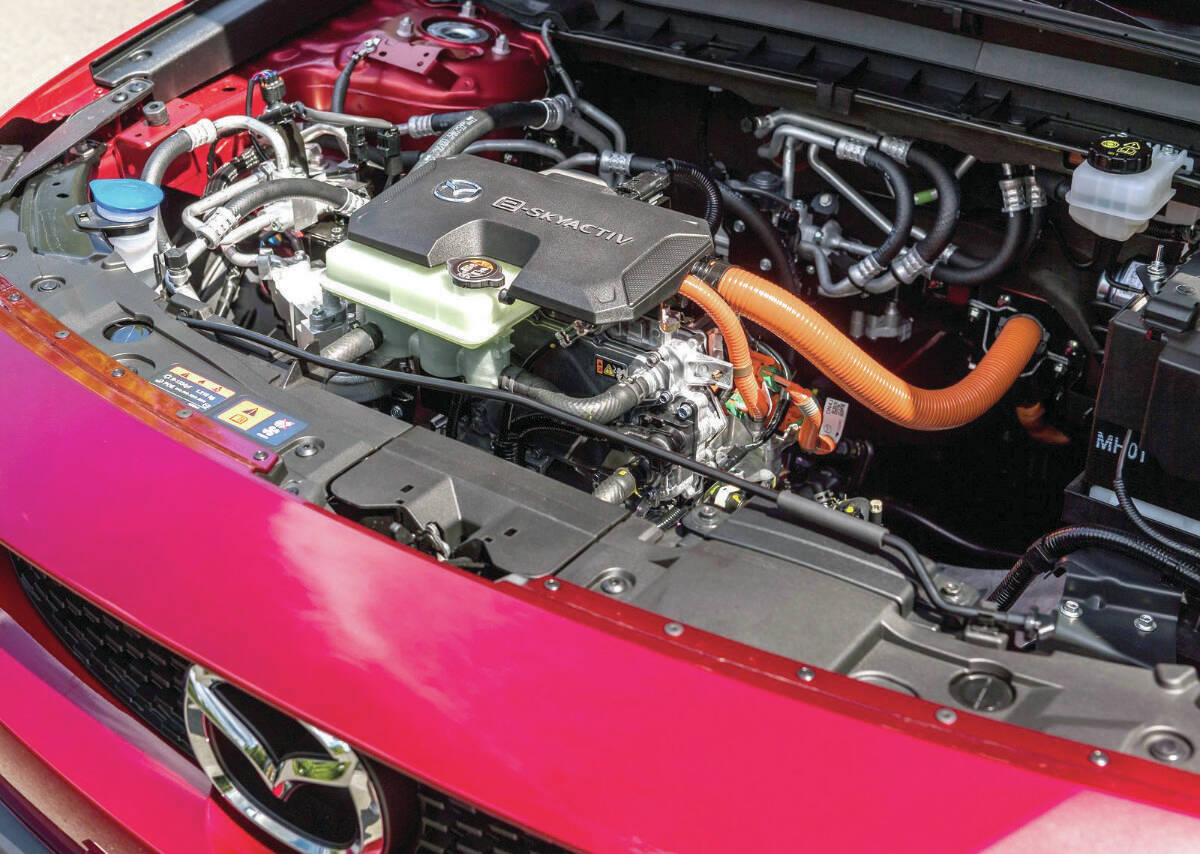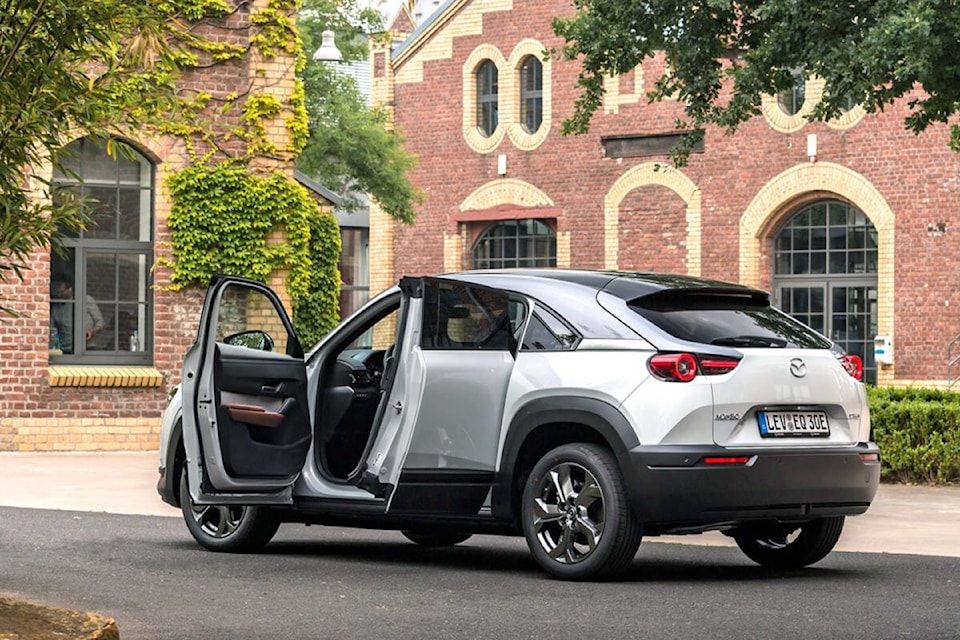Electric-vehicle first-timer Mazda is dipping its toe into the electric grid with the limited-production 2022 MX-30 hatchback.
Instead of developing a specialized EV platform, which is the case with most competing electric models, Mazda chose to build the MX-30 using the CX-30’s bones. Both cars are identical in all key dimensions and cargo capacity.
What’s unique about the MX-30 is a pair of unconventional rear doors. Actually they’re not doors in the usual sense, but rather partial-door-size openings. They latch clamshell-style from the inside and make access to the rear seat much easier than a traditional two-door coupe design, but obviously not like full-size doors would.
Setting the MX-30 apart from the CX-30 are unique pinched-nose grille and taillight treatments along with an available black-painted roof surrounded by silver grey pillars.
The MX-30’s interior is a modest departure from the CX-30’s, with variations in the control panel, door trim and the console. In both cases, the 8.8-inch touchscreen appears partially sunken beneath the dashboard.

Mazda’s new e-Skyactiv system consists of a relatively small 35.5 kilowatt-hour battery pack plus an 80.9-kilowatt electric motor. This combination produces 143 horsepower and 200 pound-feet of torque. A single-speed transmission directs power to the front wheels.
The MX-30 is therefore among the least powerful electric vehicles on the market. Another “least” is an estimated 160 kilometres of range. A 2022 Chevrolet Bolt EUV costs slightly less, has 200 horsepower and nearly 400 kilometres of claimed range.
A Level 2 station — most public charging stations and extra-cost home units — will replenish the MX-30’s batteries to 80 per cent from five per cent in close to three hours. It’s best to try sourcing a Level 3 charger (480-volt DC), which can get the job done in a bit more than 30 minutes. Recharging using a 120-volt home outlet requires an agonizing 14-hour wait. And if you drive the full 160 kilometres of range each day, then that’s 14 hours a day on the charger.
For fuel consumption equivalency, the MX-30 is officially rated at 2.4 l/100 km in the city, 2.8 on the highway and 2.6 combined.
Power and charging times aside, the MX-30 is fun to drive. The cabin is well appointed, road noise is low and the overall steering and handling is as precise as that of any Mazda vehicle. The MX-30’s suspension does a good job on rough pavement, too. The regenerative brakes function smoothly, unlike some competing vehicles in which the pedal can be touchy.

The MX-30 can’t produce rapid off-the-line bursts and the throttle response is on par with a modestly powered four-cylinder gasoline engine.
The base MX-30 costs $44,000, including destination fees, and comes reasonably loaded, including navigation, heated front seats and an eight-speaker audio system.
The GT trim gets a power moonroof, 12-speaker Bose audio system, faux leather seat covers, 360-degree surround-view monitor and 18-inch wheels (16s are standard).
The full suite of dynamic-safety technologies includes adaptive cruise control, lane-keeping assist and driver-attention alert. The GT also gets front-traffic alert and steering intervention that kicks in if the driver attempts to change lanes while another vehicle is occupying that space.
Initially, the MX-30 will be offered only in Quebec and British Columbia before eventually rolling out across Canada. Also in the works is a plug-in hybrid version that uses a range-extending gasoline engine to supply juice to the batteries.
That will definitely eliminate any issues concerning range anxiety for MX-30 buyers who would likely find owning one a more satisfying experience.

What you should know: 2022 Mazda MX-30
Type: Front-wheel-drive compact electric hatchback
Motor (h.p.): 80.9-kilowatt (143)
Transmission: Single-speed automatic
Market position: The MX-30 is Mazda’s first (and somewhat tentative) effort at creating a global electric vehicle. It doesn’t have much battery range or power, but it is in the shape of a utility vehicle, which should help popularity.
Points: Attractive bodywork is based on the existing CX-30 hatchback. • Interior has been given a more up-level appearance. • Drives and handles well despite a noticeable lack of power. • Standard array of safety tech covers most contingencies. • Given the price, 160 kilometres of range will concern prospective buyer who travel far afield.
Driver assist: Blind-spot warning with cross-traffic backup alert (opt.); active cruise control (std.); front and rear emergency braking (std.); inattentive-driver alert (std.); lane-departure warning (std.); pedestrian detection (std.)
L/100 km-e (city/hwy): 2.4/2.8
Base price (incl. destination): $44,000
BY COMPARISON
Chevrolet Bolt EUV
- Base price: $42,100
- New-for-2022 model uses a 200-h.p. motor and has a 395-km estimated range.
Hyundai Kona electric
- Base price: $45,700
- Updated 201-h.p. hatchback handles well and provides a 415-km range.
Nissan Leaf
- Base price: $37,800
- Nissan’s low-priced EV has a range of 240 or 360 kms, depending on the model.
– written by Malcom Gunn, Managing Partner at Wheelbase Media
If you’re interested in new or used vehicles, be sure to visit to find your dream car today! Like us on and follow us on



